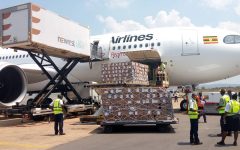 The International Air Transport Association (IATA) has released the weekly economics’ chart showing the estimated economics of an average B777-300 operation on Transatlantic, under market conditions Pre-COVID-19 versus during COVID-19 (Mar-Aug 2020). This week’s chart explores how the economics of such flights have evolved compared to before COVID-19. The association has modelled a typical North Atlantic operation with a B777-300 aircraft, assuming the market conditions before and during the pandemic. According to this this week’s chart, the average flight is almost able to cover its flight-specific operating costs (loss of US$ 2,000). This is in large part thanks to cargo revenues that now play a more important role than previously, accounting for 41 per cent of revenues vs. 9 per cent. However, the model also suggests that covering the non-flight specific fixed costs would be challenging with such low loads. This is all the more concerning as airlines need to spread those costs across their entire fleet, much of which is currently grounded or at least vastly under-utilised.
The International Air Transport Association (IATA) has released the weekly economics’ chart showing the estimated economics of an average B777-300 operation on Transatlantic, under market conditions Pre-COVID-19 versus during COVID-19 (Mar-Aug 2020). This week’s chart explores how the economics of such flights have evolved compared to before COVID-19. The association has modelled a typical North Atlantic operation with a B777-300 aircraft, assuming the market conditions before and during the pandemic. According to this this week’s chart, the average flight is almost able to cover its flight-specific operating costs (loss of US$ 2,000). This is in large part thanks to cargo revenues that now play a more important role than previously, accounting for 41 per cent of revenues vs. 9 per cent. However, the model also suggests that covering the non-flight specific fixed costs would be challenging with such low loads. This is all the more concerning as airlines need to spread those costs across their entire fleet, much of which is currently grounded or at least vastly under-utilised.
The main assumptions of the model are that passenger load factors drop to the average that airlines have reported in recent months, whilst cargo load factors as well as yields increase as a result of the shrinkage of belly capacity in the market. Fuel costs are also adjusted to reflect the recent prices. It is worth noting that the above simulation is not necessarily representative of all routes and aircraft. Demand for cargo varies largely between route areas with most demand for cargo from Asia to the rest of the world and the B777-300 is an aircraft with one of the largest belly capacities. Depending on the size of the belly and other parameters (e.g. practicalities of loading cargo), the economics of other aircraft could be less favourable. Nevertheless, this does illustrate the importance of cargo at present.
Breaking News
- Adani Ports & SEZ reports 12% growth in cargo volumes in April
- Network Airline Management expands fleet with 2 B747-400F
- Air Cargo Posts Fourth Month of Double-Digit Growth in March
- Amazon launches Sushruta programme for truck drivers
- ESR’s new 50k sq. ft. distribution center in Delhi
- RENK Group expands India ops with 92k sq ft facility in Hosur
- ‘Opportunities in Multimodal logistics needs to be explored’
- WIZ Freight Announces New Chief Commercial Officer, India, to Strengthen Supply Chain and Logistics Operations
- FedEx promotes Sustainable Growth in India
- Magellanic Cloud wins its major logistic drone order of Rs 43 cr
- Bootes, CargoPeople to launch net-zero cold storage
 Cargo Breaking News
Cargo Breaking News


